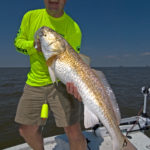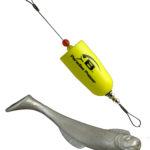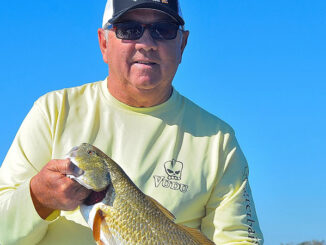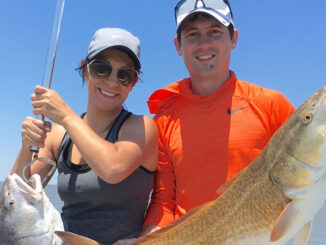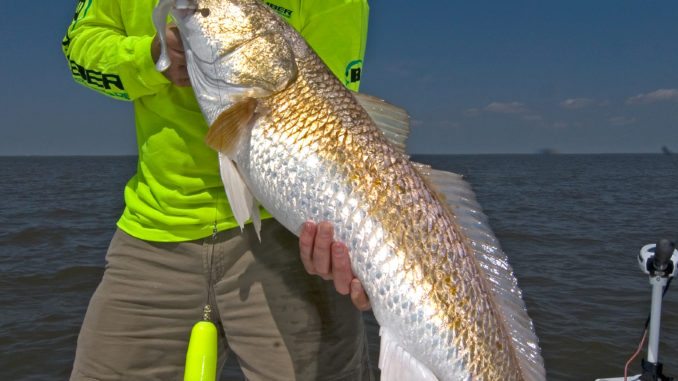
I’ve always thought redfishing with a cork was akin to reaching your hand into a hornets nest and tickling the queen – just plain painful. But after watching the guys in the boat next to me on Wednesday (April 21) slamming big bulls left and right while I just jerked on the very same rig, it was apparent there’s more to corks than just a slow, mind-numbing pop here and there.
So when we got off the water, I cornered guide Dave Iverson (225.774.0986) and Bomber Saltwater Grade’s Mark Davis – and found out the key was how they were working their corks.
“You can’t make enough noise,” Davis said. “You need to bring them to it and let them find it.”
Well, duh! But there really was more to their technique than just popping the cork and letting it sit.
“You want to pop it has hard as you can,” Davis said, adding that it’s also important to make multiple snatches in sequence. “It’s rip, rip or rip, rip, rip.
“The most important thing is the pause. Ninety-nine percent of the time, they’re going to hit it on the pause.”
The pair of anglers was just blasting the corks, producing a huge splash. But Davis and Iverson said the particular cork they were using – the Bomber Paradise Popper X-Treme – was critical to their success.
“It’s the chug and the crack: You’ll hear a balush and a crak, and it sounds just like a redfish eating a crab,” Davis said. “So they come to investigate.”
Iverson said a couple of things set the Popper X-Treme apart form other corks. First, there are two brass beads under the cork.
“Those beads slam into the cork, and make a loud crack,” he said. “A washer stops the beads from burying in the bottom of the cork, and it also helps make more noise.”
The cork also is built around a titanium wire, which Iverson does more than just make it durable.
“The wire on other corks will bend, and you can never get it straight again,” Iverson said. “That titanium wire stays straight and lets the cork run up and down easily.”
Iverson matches the cork with a 6-inch Bomber Mud Minnow, which is a lot larger than most anglers use for reds. But he said it’s important when focusing on bulls.
“I think the larger profile helps redfish to see it, and it’s about the size of the mullet I’m looking for,” he explained.
Of course, if there aren’t reds in the area it doesn’t matter what you use. So Iverson said it’s critical to concentrate on those areas holding finger mullet.
“We look for the areas that look like they have the biggest concentrations of mullet,” he explained. “I’m looking for a lot of jumpers, and if they aren’t jumping I’m looking for that nervous water.”
Iverson said bull reds bunch up along the beaches of Venice, prowling the banks and sand bars in search of groceries.
“I like that 3- to 5-foot of water,” Iverson said. “I’m not saying that the big fish won’t get up in that shallower water, but generally the shallower you get the smaller the fish are.”
There is one problem with the technique –fish often will grab the corks.
“They’re coming to the sound of the cork,” Iverson said.
While there’s no way to stop it, Iverson and Davis agreed there’s a way to lessen the likelihood.
“You want to use a short leader,” Davis said. “That way when they come to the cork they see the bait.”
Iverson said he frequently uses a 10-inch leader, but sometimes goes even shorter.
“A lot of times, especially in murky water, it never sees the bait,” he said. “But if he comes up and look at the cork and that bait is 10 inches down, he’ll eat it.”
And the strikes can be vicious because the bait is so close to the cork.
“When the come in and hit those things it’s so frickin’ violent,” Davis said. “They’re thinking, ‘Something’s getting crushed, and I’m going to get what’s left.’”
My popper fishing will never be the same.
